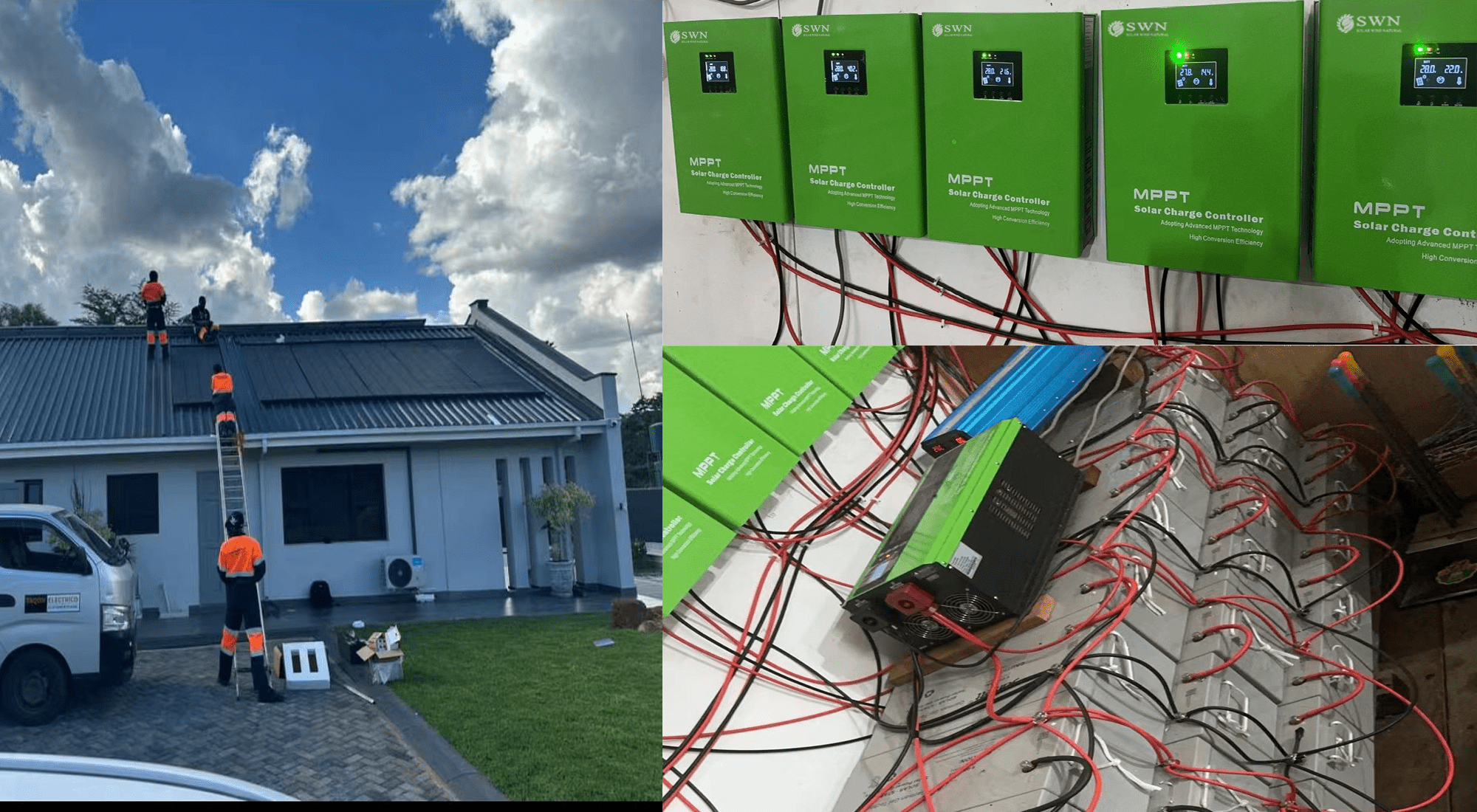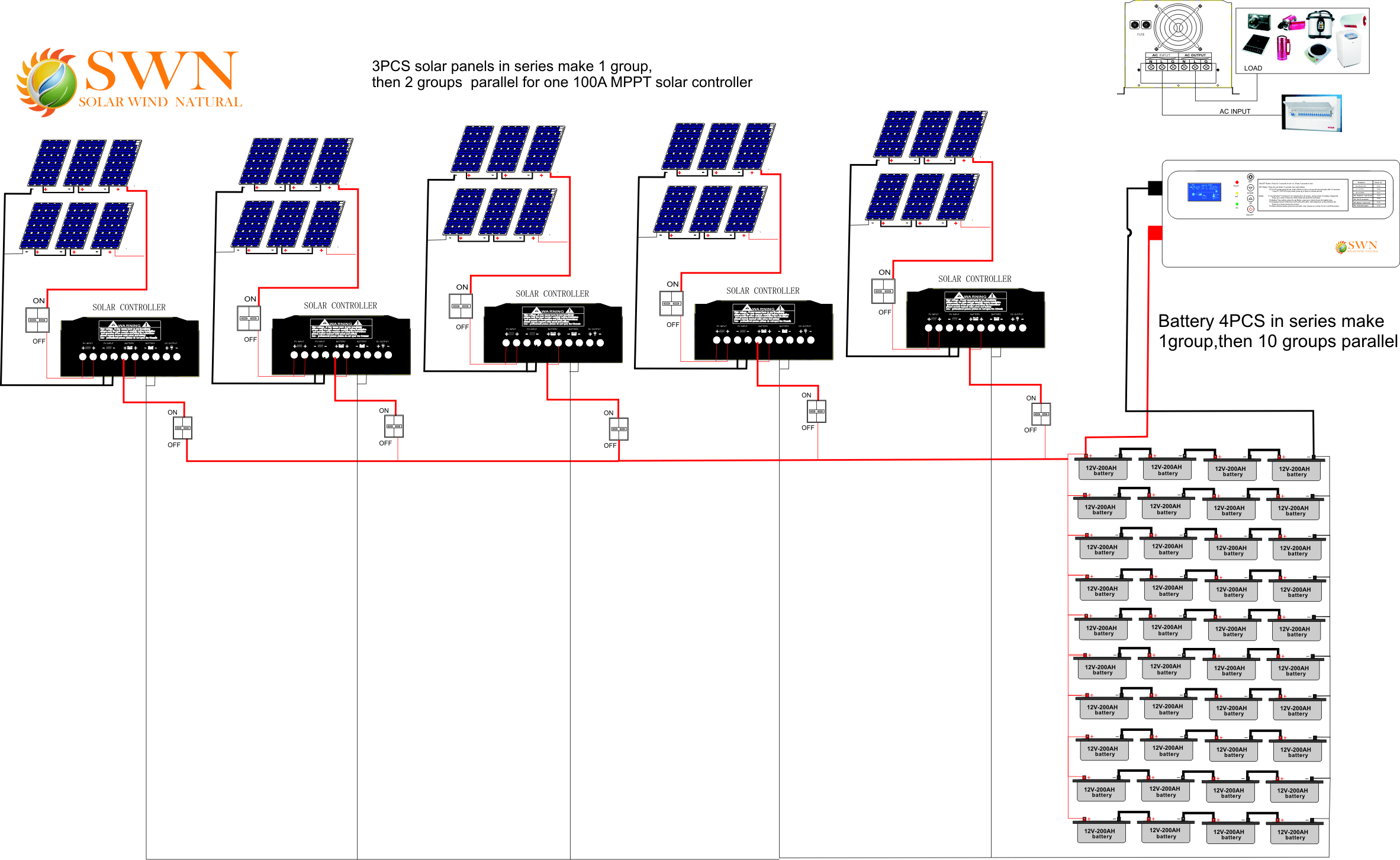Detailed Explanation of Efficient and Stable 20kW Off-Grid Solar System—Addressing User Concerns
Detailed Explanation of Efficient and Stable 20kW Off-Grid Solar System—Addressing User Concerns
When designing and selecting a 20kW off-grid solar system, users typically focus on system design, efficiency, durability, and installation considerations. For consumers considering investing in a solar system, especially an off-grid system, it is critical to understand how the system is connected, how the components interact, and the key aspects that should be considered before purchasing. This article will detail the core components of the system and answer common user questions.

1. System Overview
This off-grid solar system is designed with the following main components:
· 30 Solar Panels (665W each): These panels are organized into 5 sets, each with 6 panels.
· 5 MPPT Solar Charge Controllers (48V, 150A): These controllers manage the power from the solar panels and ensure maximum energy harvest.
· 40 Gel Batteries (12V, 250Ah each): These are responsible for energy storage, providing a reliable source of power during non-sunlight hours or cloudy days.
· 1PCS 6KW 48VDC pure sine wave low-frequency inverter
Stable low frequency Pure sine wave inverter can provide high-quality power output, suitable for various sensitive equipment, ensuring its stable operation. Its conversion efficiency is usually above 90%, making the system more energy efficient
2. System Design and Installation
During installation, the 30 solar panels are connected in series as sets of three, with two sets connected in parallel to form an efficient energy generation array. Each group of 6 panels is linked to an MPPT controller for stable voltage output. The battery system uses 12V gel batteries, combined in series and parallel to meet energy storage requirements.
3. System Connection
Solar Panels Setup:
The 30 solar panels are arranged in groups:
· String Configuration: Each set consists of 3 panels connected in series, making a total of 2 series groups per MPPT controller.
· Parallel Connection: The two groups of 3 panels are connected in parallel to match the voltage output required for the charge controller.
· Controller Input: Each MPPT controller is connected to 6 solar panels (2 parallel strings of 3 in series).
Charge Controllers:
· MPPT Technology: The 48V 150A MPPT controllers play a vital role in this system. They continuously adjust the electrical operating point of the solar panels to ensure maximum power output. This is crucial because solar panels' efficiency can fluctuate based on sunlight intensity, temperature, and other environmental factors.
· Connection to Batteries: The MPPT controllers are directly connected to the battery bank, ensuring that the power generated by the panels is efficiently stored in the batteries.
· Connection to off -grid low frequency pure sine wave inverter
1. Safety First: Ensure all power sources are disconnected before starting the installation.
Wiring the Battery:
1. Connect the battery bank to the inverter. Ensure that the inverter's DC input matches the battery voltage (e.g., 12V, 24V, 48V).
2. Use appropriate gauge wiring to handle the current and minimize voltage drop.
Wiring the Solar Charge Controller:
1. Connect the solar panels to the MPPT charge controller. Ensure that the controller is rated for the voltage and current output of your solar array.
2. Then, connect the charge controller to the battery bank to ensure that solar energy can charge the batteries effectively .
Connect the Inverter Output:
1. Finally, connect the inverter output to your load (appliances) or distribution panel. Make sure the total load does not exceed the inverter's rated capacity .
Power Up: Once all connections are secure, power on the inverter and charge controller, and check for proper operation.
Battery Bank:
· Configuration: The 40 batteries (12V, 250Ah) are connected in a series-parallel configuration to form a 48V system, aligning with the input voltage requirements of the MPPT controllers and ensuring ample energy storage.
· Energy Storage: The total storage capacity of the system ensures the home or facility has enough power to operate during non-sunlight hours, providing long-term, stable power output.
4. What should we pay attention to and what are the Key Considerations when buying a solar system?
1. Efficiency and Power Output:
· MPPT Controller Selection:
Ensure the controller has a high-quality MPPT algorithm that quickly responds to changes in panel output to maintain peak power generation efficiency.
The system is designed to maximize efficiency through MPPT charge controllers, which can boost energy harvest by up to 30% compared to traditional PWM controllers. Consumers should prioritize this feature, especially in regions with variable sunlight conditions.
2.Battery Capacity and Longevity:
· Battery Capacity and Performance:
Choose deep-cycle gel batteries for long-lasting performance to avoid rapid degradation, ensuring reliable power.
When investing in an off-grid solar system, the battery bank's size and quality are paramount. This system uses deep-cycle gel batteries, known for their reliability and longer lifecycle compared to lead-acid batteries. They require minimal maintenance, which is a significant advantage for consumers looking for low-maintenance solutions.
3. An inverter, users should consider the following:
· Power Requirements: Ensure that the inverter's rated output power exceeds the total power consumption of connected appliances. For example, a refrigerator typically requires an inverter with at least 1000 watts, while a television might need 500 watts .
· Voltage Compatibility: The inverter's input voltage must match the voltage of the batteries used (e.g., 12V, 24V,48V). Mismatched voltages can lead to inefficient operation or damage .
· Installation and Maintenance: Proper installation and regular maintenance are crucial for optimal performance. Installation should comply with manufacturer guidelines and local electrical codes .
· Manufacturer Selection: Choose reputable manufacturers known for quality and reliability. Research their product range to find the most suitable inverter model for your needs .
· Safety Features: Look for inverters with built-in safety features, such as overload protection, to prevent damage during operation .
6. System Scalability:
· System Efficiency vs. Cost: Opt for high-efficiency solar panels and controllers to reduce energy loss. Ensure compatibility between components for long-term reliability.
Consumers should ensure the system can be scaled in the future if energy demands increase. This system allows for expansion by adding more solar panels, batteries, or additional charge controllers as needed.
7. Installation and Space Requirements:
Consumers need to assess whether they have sufficient space for the installation of the solar panels and battery bank. Proper placement of the solar panels is critical for optimizing energy generation. Ideally, panels should face south (in the northern hemisphere) and be installed at an angle that maximizes sunlight exposure throughout the year.
8. Cost-Effectiveness:
While upfront costs might be a concern, this system's durability and high efficiency offer long-term cost savings through reduced reliance on traditional power sources. Additionally, government incentives or subsidies can offset the initial investment, making the system more affordable.
9.Conclusion
1) This 20kW off-grid solar system offers a reliable power solution for areas with unstable or no electricity. With its well-thought-out design and high-performance components, it can provide users with long-term, stable energy support.
2) This 20kW off-grid solar system is a comprehensive solution for individuals or businesses looking to achieve energy independence. With a robust design featuring 30 solar panels, 5 MPPT charge controllers, and 40 gel batteries, it offers high efficiency, reliability, and scalability. When choosing an off-grid system, consumers should consider the system’s power output, battery capacity, scalability, and installation requirements to ensure it meets their specific energy needs.
Key Takeaways:
· Efficient energy management through 5 MPPT controllers.
· Ample storage provided by 40 deep-cycle gel batteries.
· Scalable and reliable for off-grid applications.
By considering these factors, consumers can ensure they make an informed decision, benefiting from sustainable and cost-effective energy for years to come. more details:https://swnpower.com/products/product_categories/7/whole-house-emergency-power-inverter-system
